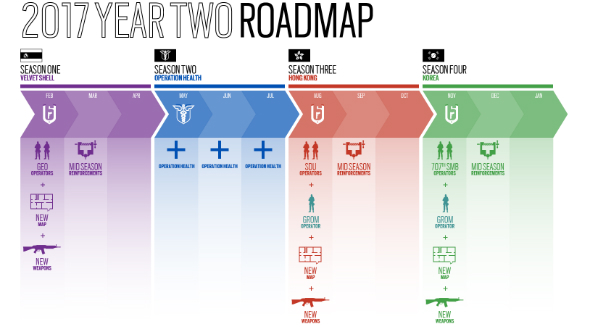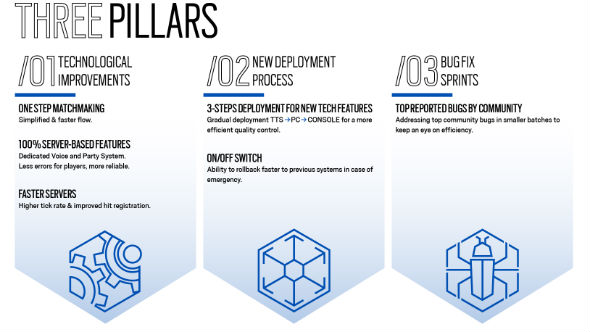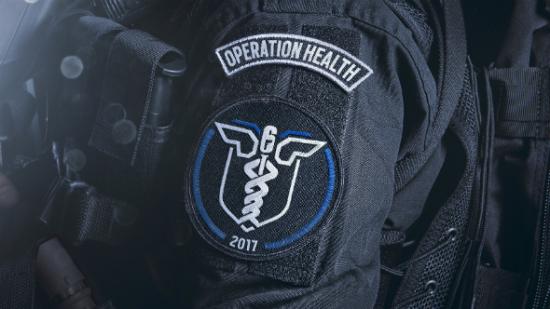Rainbow Six Siege’s rise to prominence on the multiplayer shooter stage is an unlikely tale. After a rocky launch that saw poor player numbers and sweeping changes to the meta, Rainbow Six Siege looked set to fail. A year and half later and it’s more popular than ever and still growing – a rare story in triple-A game development. That growth and success was unexpected however, and with more and more players flooding the servers with each new content release the technical strain is no longer manageable. Operation Health is Ubisoft Montreal’s answer to the issue, which will put a full season of new content on hold so that the team can focus on making the game more stable for its players, and guarantee that stability for years to come.
Just starting out in the tactical shooter? Check out the best Rainbow Six Siege operators to start wrapping your head around the meta.
It’s a bold departure from a content schedule that’s been laid out for months now, but it’s one that brand director Alexandre Remy and creative director Xavier Marquis deem absolutely necessary for the future of the game. I spoke with the pair to get an in-depth rundown of the technical changes coming to Rainbow Six Siege and the motivation behind it.
PCGamesN: So what is Operation Health?
Alexandre Remy: The idea behind it is being to fully dedicate the next three months to improving our game on all of its health aspects. That means we’re pushing back the Hong Kong season that was planned and instead focussing on technological improvements and other aspects to make the game as healthy as possible. That’s the basis of Operation Health.
Obviously, that has an impact on what was originally planned as Year Two content, but the two operators that were planned for season two will be released in the same year, but as part of season three and season four. We feel that the impact overall will be less important than you may think. We’re keeping the structure of the seasons, with the year still being broken down into four seasons of three months each. Except now, the whole of season two is being dedicated to health. Season three is now going to be the Hong Kong season, but will feature three Operators instead of two: that will be the two Hong Kong operators and one from the Polish GROM. Season Four will be South Korea and will also include three operators, two from South Korea and the last Polish GROM operator.

There will be no new content [for season two] in terms of gameplay, but we will be pushing three pillars. Pillar one is technological improvements, so everything the relies on matchmaking, hit registration, and connectivity. That’s the absolute priority for us, as well as for the players, and we’re really going to make a big, big push throughout the whole season with one-step matchmaking and better servers. The second pillar of Operation Health is switching over to a new deployment process, so that we are gradually deploying our patches, first on technical test servers, then on PC, and finally on console. This is to make sure that there are more safety nets, if you will, rather than pushing all of the content at the same time on every console. The last pillar is how we do bug fixes, whether that’s on operators or maps. The change is that we want to do smaller and shorter brackets of bug fixes, around five or ten in each sprint, instead of doing bigger updates that were sometimes causing more regressions.
Xavier Marquis: For the first pillar we are going to remove any part of the core that’s still using peer-to-peer systems. This is something we want to erase and eradicate so that everything is server-based. The main focus will be to increase the stability and connectivity for all of our players. We want to turn the game into something that’s scaleable for the future, so that the game will continue to deliver for years. It’s an investment for the long-term.
Was there anything in particular that triggered this push for game health?
AR: One thing is that when we started season one of year two, which was Velvet Shell, we had amazing results in terms of our player base. We went above three million players across the different platforms on a single day. Let’s be honest, we went through some connectivity issues and matchmaking issues because of the load. It took almost ten days to come back to a normal situation, so we were looking down the road and thinking that if this [growth] continues – and that’s the focus – we need to have a game that can scale and be sustainable for many more players and over a longer time period. Operation Health is really that big moment where we put in a lot of effort for the future of the game and invest in a big way.
There’s some aspects that you can plan ahead and think about in advance, but to be absolutely transparent with you, the success of the game is a huge surprise. The fact that we have twice as many players now as we did at launch, it’s a pattern that you don’t see very often in games. There are very few examples of games having a bigger player base a year, or a year and a half after release. When we launched we didn’t have those expectations, which is the best surprise we could hope to get. So now the vision is that the game is growing and the player base is growing, and that shifts some of our priorities. Now we can think five or even ten years down the road to invest and establish the game for the longest time possible.
Will there be any balancing changes during Operation Health?
XM: We are not talking about balancing, we are talking about fixes. So for example, we know that we are going to fix Hibana and her pellets. We are not going to focus on the balancing itself, but mainly on how operators work, so bug fixes and that sort of thing.
Balancing will come after Operation Health. We are focussing only on [game] health for the entire three months; the metagame will stay the same.
How are hoping to improve matchmaking?
XM: We are going to switch from two-step matchmaking to one-step matchmaking. Before, you had to build a team A, then build team B, and then you would have to match team A with team B. You had a kind of double matchmaking. So each time you had a disconnection, or someone left, the matchmaking bubble exploded. Now we’re switching to one-step matchmaking, so ten players will be much easier [to handle]. As soon as the matchmaking is done the ten players will be split into teams. So this, plus all the new servers, will be way more stable than before, and faster as well.
Hitboxes are also a major issue within the community, are there plans to address them too?
AR: There are two aspects to that problem. One is certainly the hitboxes, there are reworks that are being made to those right now that are going to be pushed onto the technical test server. We have reworked all the hitboxes for every character, meaning you don’t have moments where you shoot some operators that have bigger helmets and it registers as a hit – now the hits are registering purely on the human silhouette and not the whole silhouette of the operator. The second aspect is purely on hit registration. Basically, we’re switching to faster servers, which is obviously going to have a direct impact on hit registration. It’s going to be better and more reliable. To be very precise, [our] server was running at a tickrate of 50, and we’re switching to servers with a tickrate of 60.

What role will the technical test server play over the coming months?
AR: So far it’s been helping a lot, to the point where we’re changing our deployment process in the coming season. So there are those tech improvements and features that we’ve talked about, but we’re also going to make the deployment process better. Now, every big technological feature is always going to go first on test servers, then on PC, and then on console. The idea is to gradually introduce features so that we have more safety nets. If something goes wrong at one of those steps, we can revert much more easily.
How is the player base split across PC and other platforms?
AR: It is almost 25% on PC, and 75% on console. To us, PC is extremely important, [because] it’s much bigger in terms of installations than any Rainbow Six game in the past. Usually we had between 7% and 10% on PC, and the rest on console. I think it comes down to Vegas and Vegas 2, those games were hugely successful on console, and now we are gaining on the PC; it’s becoming a growing platform.
How was the reception to Year two, and what do you think the future holds for Rainbow Six Siege?
XM: People expected Year Two, we saw that on Reddit and in a few comments, and it’s something we planned since the beginning. We were a bit amused, you know, when we started the first season. We saw people on the internet saying they’re not going to do more. There was a change in behaviour from the community with season two, they said ‘Oh, that’s a surprise, finally.’ With season three, the behaviour and feedback were totally different, and by season four they were already calling for a second year of content, and that’s what we did.
AR: At the same time we were reassuring the community that we are here to stay. What I find amazing in the switch of perception from the players, is that they’re talking about Year Three, Year Four – they’re already seeing it as a long-term vision, plan, wish, or whatever. That’s amazing. Now, we can safely talk about Year Three and Year Four, and we’ve started discussing how we can plan five years ahead: how much content we can push, how many improvements we need to do. It’s about really discussing and fast-tracking the necessary developments to put the game in a state where it can last for five or ten years, or even more. These are absolutely key critical improvements and features to help us scale and sustain in the long term, which is really the direction that we want to be going in.
What do you think of Rainbow Six Siege’s health drive? Let us know in the comments below.
